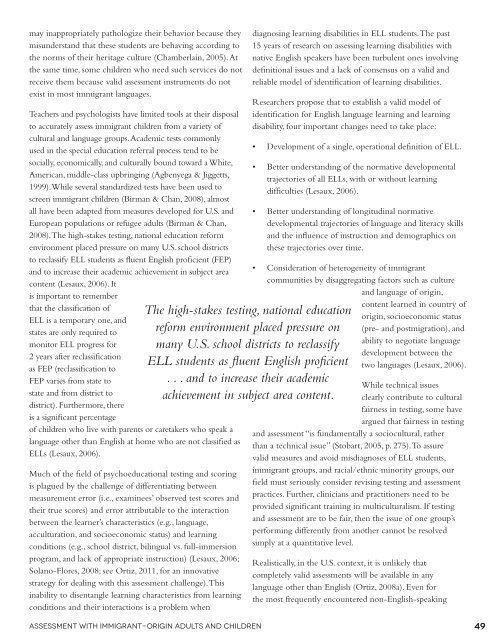Crossroads: The Psychology of Immigration in the New Century
Crossroads: The Psychology of Immigration in the New Century
Crossroads: The Psychology of Immigration in the New Century
You also want an ePaper? Increase the reach of your titles
YUMPU automatically turns print PDFs into web optimized ePapers that Google loves.
may <strong>in</strong>appropriately pathologize <strong>the</strong>ir behavior because <strong>the</strong>y<br />
misunderstand that <strong>the</strong>se students are behav<strong>in</strong>g accord<strong>in</strong>g to<br />
<strong>the</strong> norms <strong>of</strong> <strong>the</strong>ir heritage culture (Chamberla<strong>in</strong>, 2005). At<br />
<strong>the</strong> same time, some children who need such services do not<br />
receive <strong>the</strong>m because valid assessment <strong>in</strong>struments do not<br />
exist <strong>in</strong> most immigrant languages.<br />
Teachers and psychologists have limited tools at <strong>the</strong>ir disposal<br />
to accurately assess immigrant children from a variety <strong>of</strong><br />
cultural and language groups. Academic tests commonly<br />
used <strong>in</strong> <strong>the</strong> special education referral process tend to be<br />
socially, economically, and culturally bound toward a White,<br />
American, middle-class upbr<strong>in</strong>g<strong>in</strong>g (Agbenyega & Jiggetts,<br />
1999). While several standardized tests have been used to<br />
screen immigrant children (Birman & Chan, 2008), almost<br />
all have been adapted from measures developed for U.S. and<br />
European populations or refugee adults (Birman & Chan,<br />
2008). <strong>The</strong> high-stakes test<strong>in</strong>g, national education reform<br />
environment placed pressure on many U.S. school districts<br />
to reclassify ELL students as fluent English pr<strong>of</strong>icient (FEP)<br />
and to <strong>in</strong>crease <strong>the</strong>ir academic achievement <strong>in</strong> subject area<br />
content (Lesaux, 2006). It<br />
is important to remember<br />
that <strong>the</strong> classification <strong>of</strong><br />
ELL is a temporary one, and<br />
states are only required to<br />
monitor ELL progress for<br />
2 years after reclassification<br />
as FEP (reclassification to<br />
FEP varies from state to<br />
state and from district to<br />
district). Fur<strong>the</strong>rmore, <strong>the</strong>re<br />
is a significant percentage<br />
<strong>of</strong> children who live with parents or caretakers who speak a<br />
language o<strong>the</strong>r than English at home who are not classified as<br />
ELLs (Lesaux, 2006).<br />
Much <strong>of</strong> <strong>the</strong> field <strong>of</strong> psychoeducational test<strong>in</strong>g and scor<strong>in</strong>g<br />
is plagued by <strong>the</strong> challenge <strong>of</strong> differentiat<strong>in</strong>g between<br />
measurement error (i.e., exam<strong>in</strong>ees’ observed test scores and<br />
<strong>the</strong>ir true scores) and error attributable to <strong>the</strong> <strong>in</strong>teraction<br />
between <strong>the</strong> learner’s characteristics (e.g., language,<br />
acculturation, and socioeconomic status) and learn<strong>in</strong>g<br />
conditions (e.g., school district, bil<strong>in</strong>gual vs. full-immersion<br />
program, and lack <strong>of</strong> appropriate <strong>in</strong>struction) (Lesaux, 2006;<br />
Solano-Flores, 2008; see Ortiz, 2011, for an <strong>in</strong>novative<br />
strategy for deal<strong>in</strong>g with this assessment challenge). This<br />
<strong>in</strong>ability to disentangle learn<strong>in</strong>g characteristics from learn<strong>in</strong>g<br />
conditions and <strong>the</strong>ir <strong>in</strong>teractions is a problem when<br />
<strong>The</strong> high-stakes test<strong>in</strong>g, national education<br />
reform environment placed pressure on<br />
many U.S. school districts to reclassify<br />
ELL students as fluent English pr<strong>of</strong>icient<br />
. . . and to <strong>in</strong>crease <strong>the</strong>ir academic<br />
achievement <strong>in</strong> subject area content.<br />
Assessment With Immigrant-Orig<strong>in</strong> Adults and Children<br />
diagnos<strong>in</strong>g learn<strong>in</strong>g disabilities <strong>in</strong> ELL students. <strong>The</strong> past<br />
15 years <strong>of</strong> research on assess<strong>in</strong>g learn<strong>in</strong>g disabilities with<br />
native English speakers have been turbulent ones <strong>in</strong>volv<strong>in</strong>g<br />
def<strong>in</strong>itional issues and a lack <strong>of</strong> consensus on a valid and<br />
reliable model <strong>of</strong> identification <strong>of</strong> learn<strong>in</strong>g disabilities.<br />
Researchers propose that to establish a valid model <strong>of</strong><br />
identification for English language learn<strong>in</strong>g and learn<strong>in</strong>g<br />
disability, four important changes need to take place:<br />
• Development <strong>of</strong> a s<strong>in</strong>gle, operational def<strong>in</strong>ition <strong>of</strong> ELL.<br />
• Better understand<strong>in</strong>g <strong>of</strong> <strong>the</strong> normative developmental<br />
trajectories <strong>of</strong> all ELLs, with or without learn<strong>in</strong>g<br />
difficulties (Lesaux, 2006).<br />
• Better understand<strong>in</strong>g <strong>of</strong> longitud<strong>in</strong>al normative<br />
developmental trajectories <strong>of</strong> language and literacy skills<br />
and <strong>the</strong> <strong>in</strong>fluence <strong>of</strong> <strong>in</strong>struction and demographics on<br />
<strong>the</strong>se trajectories over time.<br />
• Consideration <strong>of</strong> heterogeneity <strong>of</strong> immigrant<br />
communities by disaggregat<strong>in</strong>g factors such as culture<br />
and language <strong>of</strong> orig<strong>in</strong>,<br />
content learned <strong>in</strong> country <strong>of</strong><br />
orig<strong>in</strong>, socioeconomic status<br />
(pre- and postmigration), and<br />
ability to negotiate language<br />
development between <strong>the</strong><br />
two languages (Lesaux, 2006).<br />
While technical issues<br />
clearly contribute to cultural<br />
fairness <strong>in</strong> test<strong>in</strong>g, some have<br />
argued that fairness <strong>in</strong> test<strong>in</strong>g<br />
and assessment “is fundamentally a sociocultural, ra<strong>the</strong>r<br />
than a technical issue” (Stobart, 2005, p. 275). To assure<br />
valid measures and avoid misdiagnoses <strong>of</strong> ELL students,<br />
immigrant groups, and racial/ethnic m<strong>in</strong>ority groups, our<br />
field must seriously consider revis<strong>in</strong>g test<strong>in</strong>g and assessment<br />
practices. Fur<strong>the</strong>r, cl<strong>in</strong>icians and practitioners need to be<br />
provided significant tra<strong>in</strong><strong>in</strong>g <strong>in</strong> multiculturalism. If test<strong>in</strong>g<br />
and assessment are to be fair, <strong>the</strong>n <strong>the</strong> issue <strong>of</strong> one group’s<br />
perform<strong>in</strong>g differently from ano<strong>the</strong>r cannot be resolved<br />
simply at a quantitative level.<br />
Realistically, <strong>in</strong> <strong>the</strong> U.S. context, it is unlikely that<br />
completely valid assessments will be available <strong>in</strong> any<br />
language o<strong>the</strong>r than English (Ortiz, 2008a). Even for<br />
<strong>the</strong> most frequently encountered non-English-speak<strong>in</strong>g<br />
49
















